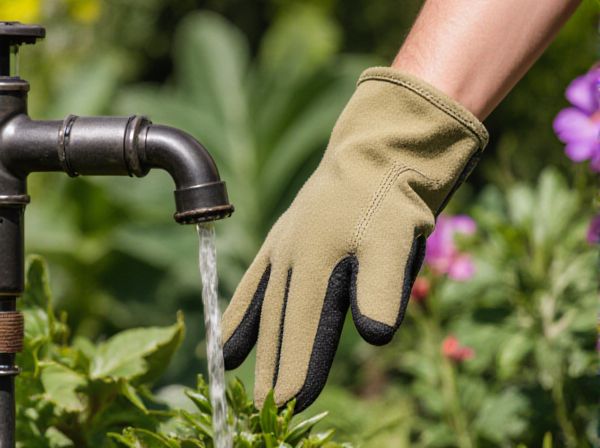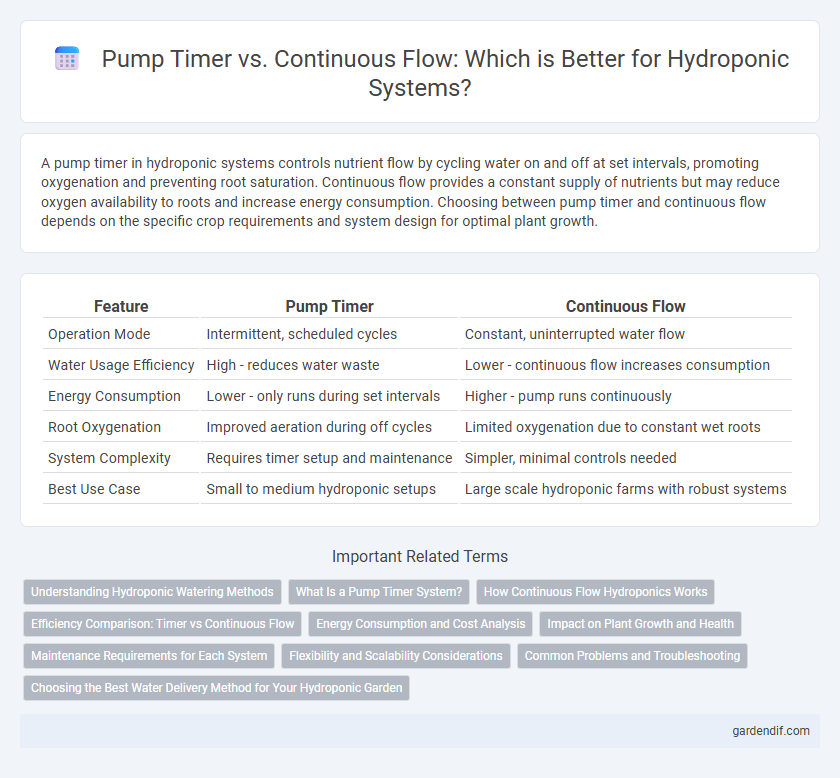
Pump Timer vs Continuous Flow Illustration
A pump timer in hydroponic systems controls nutrient flow by cycling water on and off at set intervals, promoting oxygenation and preventing root saturation. Continuous flow provides a constant supply of nutrients but may reduce oxygen availability to roots and increase energy consumption. Choosing between pump timer and continuous flow depends on the specific crop requirements and system design for optimal plant growth.
Table of Comparison
| Feature | Pump Timer | Continuous Flow |
|---|---|---|
| Operation Mode | Intermittent, scheduled cycles | Constant, uninterrupted water flow |
| Water Usage Efficiency | High - reduces water waste | Lower - continuous flow increases consumption |
| Energy Consumption | Lower - only runs during set intervals | Higher - pump runs continuously |
| Root Oxygenation | Improved aeration during off cycles | Limited oxygenation due to constant wet roots |
| System Complexity | Requires timer setup and maintenance | Simpler, minimal controls needed |
| Best Use Case | Small to medium hydroponic setups | Large scale hydroponic farms with robust systems |
Understanding Hydroponic Watering Methods
Pump timers regulate the intervals of water delivery in hydroponic systems, optimizing nutrient uptake and preventing root oxygen deprivation. Continuous flow methods maintain a constant water circulation, ensuring consistent nutrient availability but requiring careful monitoring to avoid overwatering. Selecting between pump timer and continuous flow depends on plant type, system design, and desired growth outcomes in hydroponic cultivation.
What Is a Pump Timer System?
A pump timer system in hydroponics controls the intervals at which the nutrient solution is delivered to the plants, optimizing water and nutrient use by running the pump at scheduled times. This system improves oxygenation and nutrient absorption by preventing constant water flow, reducing energy consumption compared to continuous flow setups. By automating irrigation cycles, pump timers enhance growth efficiency and minimize the risk of root diseases in hydroponic environments.
How Continuous Flow Hydroponics Works
Continuous flow hydroponics operates by constantly circulating nutrient-rich water through plant roots, ensuring a steady supply of oxygen and nutrients for optimal growth. This method utilizes pumps that run continuously, creating a dynamic environment that prevents stagnation and promotes efficient nutrient uptake. The consistent water movement also helps maintain stable pH and oxygen levels, supporting healthier and faster-growing plants compared to pump timer systems.
Efficiency Comparison: Timer vs Continuous Flow
Pump timers in hydroponic systems optimize energy usage by operating pumps at scheduled intervals, reducing electricity consumption compared to continuous flow setups that run pumps 24/7. Timer-controlled systems enhance nutrient delivery efficiency by simulating natural wet-dry cycles, promoting root oxygenation and reducing the risk of root diseases. Continuous flow systems ensure constant nutrient availability but often result in higher energy costs and increased wear on pump components.
Energy Consumption and Cost Analysis
Pump timers in hydroponic systems reduce energy consumption by operating pumps only during scheduled intervals, leading to lower electricity bills and decreased wear on equipment. Continuous flow systems maintain constant nutrient circulation, resulting in higher energy usage and increased operational costs over time. Choosing pump timers optimizes energy efficiency and cost-effectiveness, making them suitable for sustainable and budget-conscious hydroponic setups.
Impact on Plant Growth and Health
Pump timers regulate nutrient delivery in hydroponic systems, promoting oxygenation and reducing root rot by allowing intermittent wet and dry cycles, which enhance root respiration and nutrient uptake. Continuous flow systems maintain constant nutrient circulation, ensuring steady nutrient availability but increasing the risk of oxygen deprivation and root diseases if flow rates are insufficient. Optimal plant growth and health in hydroponics depend on balancing nutrient delivery with root oxygenation, where pump timers often provide superior results over continuous flow by preventing waterlogging and encouraging robust root development.
Maintenance Requirements for Each System
Pump timers in hydroponic systems require regular inspection to ensure timers function correctly and pumps remain free of debris, reducing wear and preventing electrical issues. Continuous flow systems need consistent monitoring of pump operation and tubing to avoid clogs and mechanical failures due to nonstop usage. Both systems benefit from routine cleaning and maintenance, but continuous flow setups generally demand more frequent checks to sustain optimal performance.
Flexibility and Scalability Considerations
Pump timers offer greater flexibility by allowing precise control over water and nutrient delivery intervals, which can be adjusted based on plant growth stages and system requirements. Continuous flow systems provide consistent nutrient supply but may lack scalability for larger or diverse crop setups due to fixed operation parameters. Selecting between pump timers and continuous flow depends on the need for customizable irrigation schedules and the scale of the hydroponic operation.
Common Problems and Troubleshooting
Pump timers in hydroponics often face issues like improper scheduling leading to nutrient imbalances and root oxygen deprivation. Continuous flow systems can encounter pump failures or clogging, resulting in uneven nutrient distribution and system downtime. Troubleshooting involves checking timer settings for accuracy, inspecting pump functionality, and ensuring clean filters to maintain consistent water flow.
Choosing the Best Water Delivery Method for Your Hydroponic Garden
Pump timers regulate water delivery by cycling nutrients on and off, optimizing oxygen availability and preventing root rot in hydroponic systems, while continuous flow ensures steady nutrient circulation but may increase energy consumption and reduce oxygen levels. Selecting the best water delivery method depends on the specific crop's water and oxygen requirements, system design, and energy efficiency priorities. Many hydroponic growers prefer pump timers for their ability to balance moisture and aeration, promoting healthier root development and higher yields.
Pump Timer vs Continuous Flow Infographic

 gardendif.com
gardendif.com